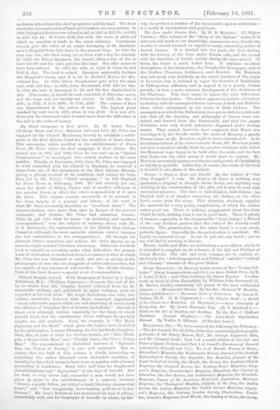My Third Campaign in East Africa. By W. Salter Price.
(William Hunt and Co.)—Between 1874 and 1876, Mr. Price was engaged by the Church Missionary Society to establish a settle- ment on the East African Coast for the reception of freed slaves. This enterprise, which resulted in the establishment of Frere Town, Mr. Price styles his first campaign in East Africa. His second was in 1881 and 1882, when he was sent out as "Special Commissioner" to investigate into certain matters in the same quarter. Finally, in December, 1887, when Mr. Price was engaged in work connected with his Church in England, he received a letter from one of the secretaries of the East African Mission, giving a gloomy account of its condition, and asking his help. This led to Mr. Price's "third campaign r" he loft England for Frere Town in February, 1888. He had scarcely got out, when the death of Bishop Parker and of another colleague in the mission throw, in effect, the whole responsibility of it upon Mr. Price. This volume consists essentially of an account, in the form largely of a journal and letters, of his work in what Mr. Price accurately describes as "troublous times." The mission-stations were more than once in danger of the gravest character ; and besides, Mr. Price had numerous worries. Thus, he got into what ho terms "an irritating and needless correspondence" over the subject of runaway slaves with Mr. G. S. Mackenzie, the representative of the British East African Company, although the most amicable relations existed between the two contributors to the correspondence. All through his journals, letters, narrative, and actions, Mr. Price „figures as an earnest, simple-minded Christian missionary. Otherwise his little book is valuable as revealing under what difficulties the pioneer work of civilisation is conducted in such a country as that in which Mr. Price has now laboured so much, and also as giving us the photographs of men who are incapable of selfish self-assertion, but are capable of any amount of self-sacrifice. The lifelike illustra- tions of this book deserve a special word of commendation,


































 Previous page
Previous page